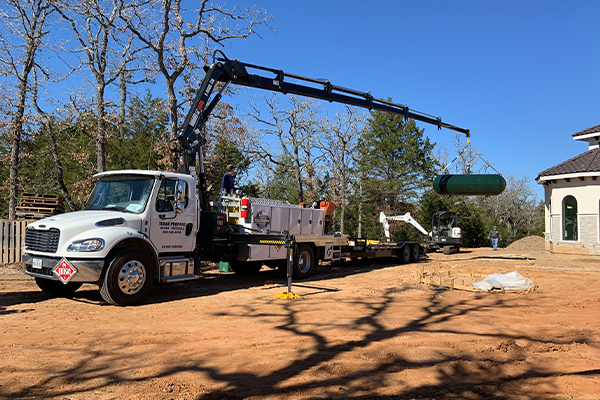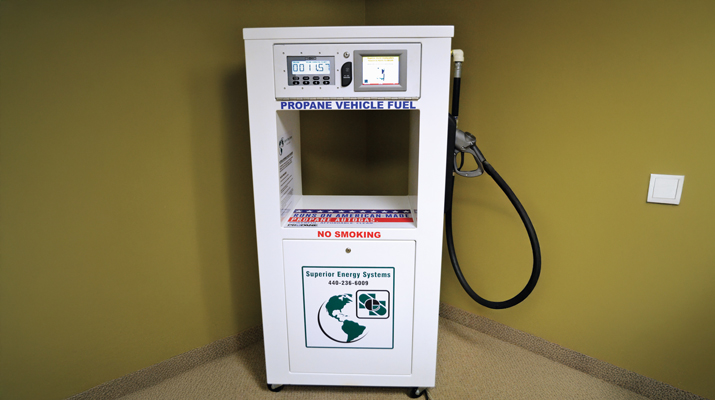Tank size selection requires pre-installation assessment
Connecting customers with a correctly sized propane tank is a process containing several variables that retailers need to address.

Photo by Mike Todd/Texas Propane
There is no set approach for setting a tank’s appropriate volume given the nation’s wide array of weather conditions; heating a swimming pool in Duluth, Minnesota, is going to be a lot different than in Duluth, Georgia.
And so it is also for fueling furnaces and space heaters, stoves, dryers, standard- and instant-hot water heaters, grills, gas logs and fireplaces, outdoor living amenities, agricultural uses and other applications.
Some of the more obvious factors, along with considering an area’s climate, include the anticipated appliance load, the tank’s desired location on the property and whatever community regulations and zoning statutes are in play.
Usage patterns within the surrounding neighborhood are widely applied measures for estimating expected usage in conjunction with local temperatures and the home’s appliances, while a new installation at a commercial account is likely to require a more detailed analysis of the propane-powered fixtures and their expected loads.
Choosing between aboveground and underground tanks is another factor, as is deciding whether you wish to sell your tanks directly to the customers or retain ownership, responsibility and access through rent/lease arrangements.
Retailers report that when determining a tank’s size they tend to favor a slightly larger capacity than initially calculated to better control the timing and frequency of deliveries without the customer running out of gas – especially during periods of peak demand.
“It all depends on the size of the home and the type of appliances,” says Francis Hartnett, who runs the petroleum department at the Southern States Smyrna/Clayton Cooperative in Clayton, Delaware.
Farmer-owned since 1923, “We retain ownership of the tank in most cases.” A typical installation is done in an hour by a crew of two at $60 to $70 in labor with no cost to the customer.
If the end user moves, the company’s general policy is to leave the tank in place until advised otherwise by the new occupant. If a customer selects a competing propane provider or different energy source, “we’ll come and get the tank and bring it home,” Hartnett says.
“Aesthetics is the key decision for the customer” when choosing between an aboveground or underground tank, yet an in-ground 500-gallon model can be considerably more expensive at a cost nearing $4,000. Hartnett’s contractor who does these below-grade installations charges a flat fee of $500.
A larger-than-estimated vessel is utilized because “I only want go there once” for an installation project.
Price-wise, “we’re right in the middle” of the other propane retailers in the area, says Hartnett, who also markets fuel oil, diesel, kerosene and gasoline.
It is seldom necessary to refurbish a propane tank as it typically remains in good shape, he says, and there’s very little clientele churn because the farm services co-op has lost only three customers in the past five years.
“I have the best advertising – my customers,” Hartnett says. “We are extremely customer-friendly and customer-oriented. We go the extra step to take care of our customers.”
Clocking travel times
At InterState Propane, based in Sacramento, California, about two-and-a-half hours are allowed for a routine tank installation job. It can take longer depending on the tank setting’s precise location on the property, the setback from the road or driveway and “if we have to drag it in by hand” because of obstructions and other site-specific challenges, according to Richard Martinelli, the company’s director of propane services.
Load assessments are a bit more complicated due to a high amount of propane-powered auxiliary electrical generators that are deployed at the region’s residences and commercial enterprises.
Tank sizing is additionally calculated by clocking bobtail travel times and how they fit in with InterState’s delivery scheduling. A property farther out rates a larger tank size to reduce the frequency of fill-up runs.
“We do a lot of new installations where there’s not a history of propane use,” says Martinelli, meaning that the usage assessment carries increased importance when reviewing the appliances present at the account. The process includes assessing Btu and expected ambient temperatures to be addressed by the amount of gas in the tanks.
“If it’s a small usage, we can get away with using a smaller tank,” Martinelli points out.
InterState aims to own most of the tanks, but the area retains a history that remains at odds with that strategy.
“A lot of people back years ago put in their own tanks to get that day’s lowest price, but that’s changing,” Martinelli muses, pleased with a heightened level of market stability.
Calculating fixture load
Serving the Four Corners region that also encompasses the Navajo Nation along with parts of Arizona, Allaround Propane offers budget-minded weekly deliveries.
Underground tanks tend to be too pricey for the customer base, but the company – based in Fruitland, New Mexico – does a brisk business with aboveground tank installations.
Like most propane retailers, Allaround buys its tanks by the truckload.
On average, 130 to 150 tanks are bought per year; 50 to 55 vessels of varying volumes arrive with each delivery. They are stored in the company’s yard until needed for installation.
As for selecting the proper volume, “we go off of what their fixture load is. I have a plumbing and heating background, and I’ve been doing this for 40 years,” explains CEO T. Brad Duncan.
“There are a number of variables that need to be taken into account.”
An inventory of a home’s appliances includes finding out if they have a wood stove, as that impacts the amount of propane being consumed.
“You can pretty much tell by where they live and the size of the home,” says Duncan in elaborating on the tank-size analysis.
Other queries include: “Is it a new stick home, a mobile home, or are they switching from natural gas?” In addition to dictating a tank’s desired capacity, other factors for which Duncan accounts can add time to the tank installation process, such as new ditching.
A new installation takes about four to five hours. “If I’m swapping out a tank, it’s a one-hour to two-hour thing,” explains Duncan.
All of Allaround’s tanks are rented by the customers at an array of rates. “We do not sell our tanks,” Duncan asserts. “That would be selling our assets.”
A similar approach is taken by Peter Iacobucci, general manager at Palmer Gas & Oil in Atkinson, New Hampshire.
“We try not to sell our assets – we own the tanks,” he says.
Established in 1932, Palmer Gas & Oil owns 90 percent of the customer base’s tanks.
Maintaining an always-adequate stock of the vessels is a top priority in the wake of a tank shortage that hit with a rise in demand a couple of years ago.
The steel market can be volatile, and the company doesn’t want to get caught short. “We have a large storage yard, so we keep plenty in stock. We forecast out through the year,” says Iacobucci.
Tank refurnishing is actively pursued as well.
Refurbished tanks are in high demand, but available supply tends to be low at Valley Farmers Supply, headquartered in Worden, Montana, according to Energy Director Brad Sullivan.
“I like to have choices,” says Sullivan, lamenting the lingering shortage. “I would like to have that as an option for my customers if they prefer to purchase a gently used tank.”
In Big Sky country, there is a good amount of agricultural applications amid numerous outbuildings that serve an assortment of purposes. Upon arriving at a property, “we’ll look at how many furnaces and other large-consuming appliances that they have,” says Sullivan.
About 70 percent of the tanks are rented by the customers, and installations are done by an in-house crew. “We have our own employees that are nested within the company to do that work,” Sullivan reports.
At Collins Propane in Wylie, Texas, the “rule of thumb” is that the company retains ownership of a tank when it’s fueling a furnace. If the propane is used for other purposes, the customer buys the tank or pays a flat lease fee based on the tank size.
“If there’s no heat on propane, you’ll need a smaller tank,” says operations manager Clayton Collins. “If the customer wants a larger tank and I can justify it, I’ll put it in for them.”
Guide for sizing tanks
Foster Fuels, headquartered in Brookneal, Virginia, with seven area locations, has prepared a guide for selecting tank sizes:
- 120-gallon propane tanks, vertical or horizontal: The 120-gallon model is ideal for providing fuel in homes with one or two propane appliances. Measuring just 4 ft., 6 in. tall and 30 in. in diameter when upright, this space-saving unit is an unobtrusive addition to any residential property.
- 325/500-gallon propane tanks: A 325- or 500-gallon tank provides enough fuel to meet the needs of commercial cooking operations or for homeowners using propane to power their furnaces, water heaters or up to five smaller appliances.
- 1,000 gallons: Use a 1,000-gallon tank – aboveground or underground – for whole-home heating or light- to medium-duty commercial/agricultural applications. Many homeowners opt for a 1,000-gallon propane tank so they can purchase in volume and take advantage of lower summer fuel prices.
- More than 1,000 gallons: For clients with special propane needs, Foster Fuels can design and install custom propane tanks capable of storing anywhere between 10,000 and 30,000 gallons of fuel. Previous clients have included schools, hotels, healthcare facilities and industrial plants.
















